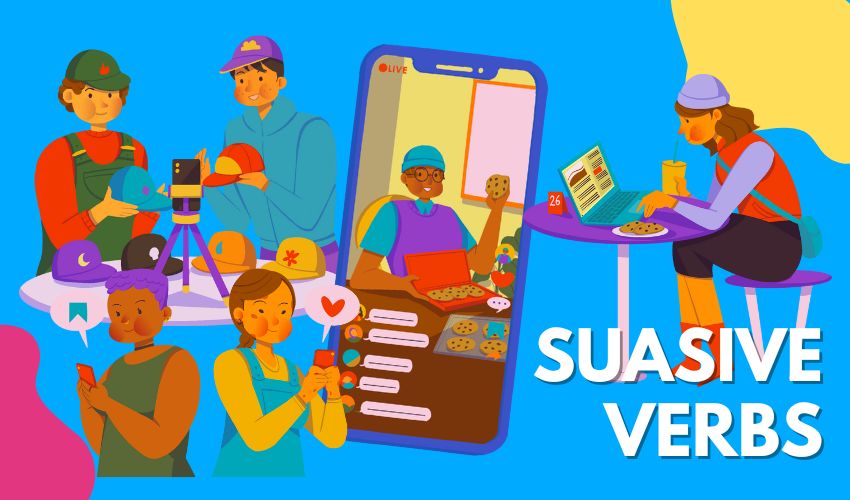The Power of Verbs in “Calls to Action”

In digital marketing and content creation, a "Call to Action" (CTA) is a crucial element that prompts your audience to engage with you in some way of value.
The Power of a Verb to Influence Action
The choice of verbs you use in a CTA can significantly impact its effectiveness. For influencers, marketers and brands, understanding the types of verbs - imperative, modal, and suasive - and their use in crafting compelling CTAs is essential.
Understanding Imperative Verbs in CTAs
Imperative verbs command or request an action. Examples include 'Buy', 'Download', 'Subscribe', or 'Register'. They are direct and create a sense of urgency.
These verbs are effective in sales CTAs because they clearly state what action the reader should take, leaving no room for ambiguity.
The Role of Modal Verbs in Calls to Action
Modal verbs, such as 'can', 'may', 'should', or 'must', suggest possibility, ability, permission, or obligation. In CTAs, they soften the command, making the action seem less imposing.
A CTA like “You can start your free membership today” uses a modal verb to suggest an opportunity rather than impose an action.
Suasive Verbs for CTA Persuasion
Suasive verbs are persuasive; they encourage the reader to believe in the possibility and benefits of an action. Words like 'Discover', 'Experience', or 'Explore' fall into this category. They are less commanding than imperative verbs and are ideal for inviting the audience to learn more or engage with content in a less direct way.
Suasive verbs are useful for influencers looking to create connections and group engagement.

Choosing the Right Verb for Your CTA
The selection of verbs in CTAs should align with your desired engagement type. For immediate actions like sales, imperative verbs are highly effective. Modal verbs are suitable for actions that require contemplation or carry less urgency. Suasive verbs work well for educational content or experiences where the audience needs to be drawn in gently (areas such as mental health, spaceflights, mergers and acquisitions as well as other areas where huge amounts of trust need to built up before direct engagement can begin).
Calls to Action - Driving the Need to Take Action
CTAs must create a sense of necessity. This is where the choice of verb plays a pivotal role. An imperative verb like 'Act now' instills urgency, while a suasive verb like 'Uncover' intrigues and draws the audience in, making them feel they are about to embark on a journey of discovery.
Persuasive Triggers in CTAs
Persuasive triggers in CTAs are elements that provoke an emotional or psychological response, compelling the reader to act. These include creating a sense of urgency, offering something of value, or evoking curiosity. The right verb can act as a persuasive trigger, making the CTA more compelling.
Here are 10 examples of calls to action (CTAs) that effectively use persuasive triggers to encourage engagement:
- Limited Time Offer: "Buy now and save 30%! Offer ends in 24 hours!"
- Trigger: Urgency and fear of missing out (FOMO).
- Exclusive Access: "Join our VIP club and get exclusive access to members-only deals!"
- Trigger: Exclusivity and desire for belonging.
- Curiosity and Learning: "Discover the 5 secrets to double your productivity – Download the free guide now!"
- Trigger: Curiosity and desire for self-improvement.
- Social Proof: "Join 10,000+ satisfied customers and experience the difference today!"
- Trigger: Social proof and trust building.
- Free Trial: "Start your free 30-day trial and see the results for yourself – no credit card required!"
- Trigger: Risk aversion (no financial commitment).
- Personal Gain: "Transform your skills with our advanced course – Enroll now and advance your career!"
- Trigger: Aspiration and personal advancement.
- Problem-Solving: "Struggling with weight loss? Try our proven plan for free and see the difference!"
- Trigger: Solution to a problem and hope.
- Competition: "Enter our contest to win a free trip to Hawaii! Don’t miss your chance to explore paradise."
- Trigger: Competition and excitement.
- Direct Benefit: "Get 50% more points on your next purchase. Shop now and reap the rewards!"
- Trigger: Immediate benefit and gratification.
- Emotional Appeal: "Help us make a difference. Donate now and support children in need."
- Trigger: Empathy and the desire to help.
Each of these CTAs leverages a specific psychological or emotional trigger, from urgency and exclusivity to curiosity and empathy, to motivate the audience toward a desired action.
Using Persuasive Triggers Effectively
Effective CTAs use persuasive triggers strategically. For instance, combining an imperative verb with a time-sensitive offer (“Buy now and save 50%”) creates urgency. Similarly, pairing a suasive verb with a curiosity element (“Discover the secrets to effective marketing”) can be highly enticing.
Here are eight examples of calls to action that utilize imperative, modal, or suasive verbs, each paired with a persuasive trigger:
- Imperative + Urgency:
- "Book now to secure your spot at the exclusive seminar!"
- Verb: Book (Imperative)
- Trigger: Urgency and exclusivity
- "Book now to secure your spot at the exclusive seminar!"
- Modal + Opportunity:
- "You can save up to 50% on your first order. Sign up today!"
- Verb: Can save (Modal)
- Trigger: Financial incentive and opportunity
- "You can save up to 50% on your first order. Sign up today!"
- Suasive + Curiosity:
- "Discover the hidden secrets of successful entrepreneurs with our free ebook."
- Verb: Discover (Suasive)
- Trigger: Curiosity and value offering
- "Discover the hidden secrets of successful entrepreneurs with our free ebook."
- Imperative + Social Proof:
- "Join thousands of satisfied customers. Try our product now!"
- Verb: Join, Try (Imperative)
- Trigger: Social proof
- "Join thousands of satisfied customers. Try our product now!"
- Modal + Assurance:
- "You could improve your skills dramatically with our online courses."
- Verb: Could improve (Modal)
- Trigger: Personal development and potential
- "You could improve your skills dramatically with our online courses."
- Suasive + Emotional Appeal:
- "Explore ways to make a lasting impact on the environment. Start your journey today."
- Verb: Explore, Start (Suasive)
- Trigger: Emotional appeal and a call to action for a cause
- "Explore ways to make a lasting impact on the environment. Start your journey today."
- Imperative + Exclusivity:
- "Claim your exclusive member discount before it’s gone!"
- Verb: Claim (Imperative)
- Trigger: Exclusivity and limited availability
- "Claim your exclusive member discount before it’s gone!"
- Modal + Risk Aversion:
- "You should see what you’re missing out on! Register for a free trial."
- Verb: Should see (Modal)
- Trigger: FOMO (Fear of Missing Out) and no-risk trial
- "You should see what you’re missing out on! Register for a free trial."
Each of these examples pairs a specific type of verb with a persuasive trigger, aiming to motivate the audience to take immediate and decisive action.
Put the Power of Verbs into Your Calls to Action
In crafting CTAs, the choice of verb - be it imperative, modal, or suasive - plays a critical role in determining the effectiveness of the message. It's essential to align the verb with the type of engagement you seek and use persuasive triggers to enhance the CTA's impact. By carefully selecting the right verbs and crafting messages that trigger a response, you can significantly increase the likelihood of your audience taking the desired action.

